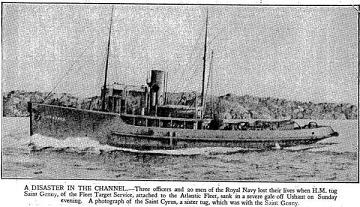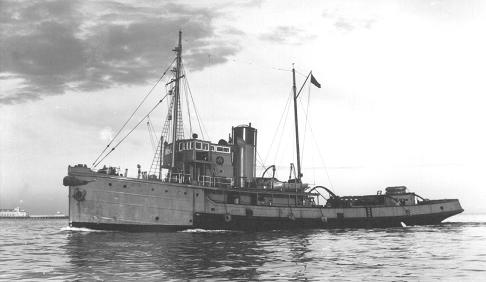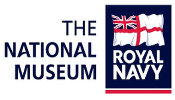ACCOUNTS
FROM "THE TIMES"
Published
in "The Times" 14th
January 1930.
HMS
St. Genny
Sunday
12th January 1930
THE
GREAT GALE
NAVAL TUG SUNK IN CHANNEL
23
LIVES LOST
Further
news of the severe gale which swept a large part of the
country on Sunday night emphasizes its intensity. Many
deaths were caused by accidents on land and sea.
The
most serious loss of life occurred when the naval tug
St. Genny was struck by a huge sea and sank in the
English Channel off the island of Ushant. Three officers
and 20 ratings were lost, and there are only five
survivors.
The
loss of the St Genny was officially announced yesterday
as follows:-
The
secretary of the Admiralty regrets to announce that H.M.
tug St. Genny, of the Fleet Target Service, attached to
the Atlantic Fleet, sank in a severe gale at
approximately 8.20 p.m. yesterday (Sunday) evening with
the loss of 23 lives, about 32 miles north-west of
Ushant.
The
following have been saved:-
Petty Officer Henry BROTHERTON, J 20237.
Stoker George BROOKS, K 10343.
Signalman William SULLIVAN, J 64480.
Able Seaman Hector ELLIOTT, J 43713.
Able Seaman Alfred J. JENKINS, J 03625.
REPORT LOST
OFFICERS
Lieutenant Charles Frederick PAUL.
Commissioned Gunner Philip Stanley LEAN.
Boatswain Charles Henry Beedell BURREN.
RATINGS
Harold BANKS (A.B.), J 32459 (Chatham).
Herbert George CIVIL (C.E.R.A., 1), m 804
(Chatham).
Alfred Edward Lionel COOMBES (Sto. 1st),
K.X. 76581 (Chatham).
Richard
Robert COTTON (Sto. 1st), K 62113 (Chatham).
James
CROWTHER (Sto. 1st), K 16109 (Devenport).
Thomas
FRAY (E.R.A., 2nd), M 34649 (Chatham).
Leonard
Charles GREEN (Sto. 1st), K 62435 (Chatham).
Frederick James Benjamin HEBEL (Ldg. Sto.), K 59712
(Chatham).
George Arthur HOWES (A.B.), J 105307 (Chatham).
Sydney Richard KELLINGTON (A.B.), J 92220 (Chatham).
Claud William Nevell KEMP (Off. Std. 2nd),
L 12749 (Chatham).
Frederick
Andrew KNIGHT (Sto. 1st class), K 65419 (Chatham).
Paul MAITLAND (A.B.), J 100943 (Chatham).
William Henry PEPLER (E.R.A. 1st),
M 14878 (Chatham).
Frederick George PINK (Ldg. Sto.), K 59106 (Chatham).
Albert James PRIEST (Off. Std. 3rd),
L 14694 (Chatham).
Henry
Albert RAVEN (Sto. 1st) K 58432 (Chatham).
Sidney Silvester TITMUS (A.B.) J 106605 (Chatham).
John Thomas WILLIS (Ldg. Sto.) K 2294 (Devonport).
Thomas John WILLOUGHBY (Tel.) J 48094 (Chatham).
Published in "The Times" 14th
January 1930.
(From
Our Correspondent)
Weymouth,
Jan. 13.
STRUCK BY BIG WAVE
RESCUES BY COMPANION SHIPS
News
of the disaster to the tug St. Genny was received with
surprise in the Atlantic Fleet at Portland. It was
pointed out that while she was not a very large vessel,
she was well built and very powerful, and had weathered
very severe storms off the French coast during similar
journeys with the Fleet in previous years.
Information received at Portland this evening shows
that at the time of the disaster, 8.20 on Sunday
evening, the wind was blowing at a rate of between 70
and 80 miles an hour, and at times reached 100 miles
an hour. The St. Genny, her sister tug, St. Cyrus, and
the sloop Snapdragon left Portland together on
Saturday, and hove to about 30 miles N.W. of Ushant in
the
hope that the storm would abate. The three ships were
within half a mile of each other. After one huge wave
had swept the St. Cyrus and the Snapdragon, the
look-out men missed the St. Genny. Searchlights were
thrown on the spot where she was seen last, and
several men were observed struggling in the water. The
two ships approached the spot, and life lines were
thrown to the drowning men, who were wearing
lifebelts. In this way five men were saved. Owing to
the heavy seas it was impossible to launch a lifeboat.
The
light cruiser Frobisher, which was at Portland, was sent
early this morning to give what help she could, but no
men could live long in such rough sea, even if they had
lifebelts or had found wreckage. It is believed that a
huge wave stove in the plates of the St. Genny, that
there was a tremendous inrush of water, and that only
the men on deck had a chance to escape, those below
being caught in a trap. The Admiralty has ordered an
inquiry.
The
departure of the Atlantic Fleet for Spanish and
Mediterranean ports has been postponed for 24 hours in
consequence of the rough weather. The ships will leave
port at 2 o’clock tomorrow afternoon.
THE
KING’S SYMPATHY
The
following telegram has been received by the Admiralty:-
"The
King is much distressed to hear of the sinking of H. M.
Tug Saint Genny during yesterday’s storm, and asks that
you will convey to the relatives of all those who lost
their lives an expression of his Majesty’s sincere
sympathy."
The
cruiser Frobisher, escorting the sloop Snapdragon and
the tug St. Cyrus, with the survivors of the St. Genny
aboard, arrived off Plymouth at 8 o’clock last night,
and anchored in the Sound. It was understood that the
survivors would remain aboard during the night and land
at Davenport Dockyard this morning.
LIEUT.
PAUL AND HIS SHIP
The
St. Genny belonged to the "Saint" class of the fleet
tugs built late in the War, and was of about 425 tons
gross, with a length of 135ft., beam of 30ft., and a
maximum draught of 14½ft. She was a single screw ship,
with engines of 1,250 horsepower, giving her a nominal
speed of 12 knots. The St. Cyrus and the St. Genny were
attached to the Atlantic Fleet Target Service, and the
latter finished a refit at Chatham yard only on January
4, before leaving for the Mediterranean to take part in
the spring cruise of the Fleet.
The
St. Genny had been commanded since April 30 by
Lieutenant C. F. Paul, R.N., formerly second-in-command
of the fishery protection trawler Kennet.
Lieutenant
Paul was born on November 18, 1882, and was promoted to
the warrant rank of gunner in August, 1914, and
appointed to H. M. S Lord Nelson, flagship of Admiral
Sir Cecil Burney. He remained in the ship when she was
sent to the Eastern Mediterranean, where she was
flagship of Vice-Admirals de Robeck and Thursby. From
October 1 1917, he served in the destroyer Express. He
was promoted commissioned gunner in August, 1924, and
lieutenant in June, 1928, after two years at Chatham
Gunnery School.

Published
in "The Times" 15th January 1930.
(from Our correspondent)
Plymouth, Jan. 14.
THE
LOST TUG
GALLANT RESCUE OF SURVIVORS
SISTER SHIP’S PLIGHT
The
full account of the rescue of the survivors of the naval
tug St. Genny, which foundered in the gale on Sunday
evening when about 40 miles off Ushant with the loss of
23 lives, reveals the heroism exhibited by the captain
and crew of the sister tug St. Cyrus, who rescued five
men in seemingly impossible conditions.
The
St. Genny was steaming to Gibraltar in company with the
sloop Snapdragon and the tug St. Cyrus, and was sunk by
mountainous seas at a quarter to 8 on Sunday. The story
of what happened was told by Lieutenant Henry Melville,
the captain of the St. Cyrus.
The
St. Cyrus herself, it appears, had a very narrow escape
from disaster. About 3 o'clock on Sunday afternoon, soon
after the gale sprang up in the Channel, the tug had her
steam steering gear put out of action. This put the
vessel in great danger, as if she had got broadside on
the heavy seas she would have stood little chance. The
captain ordered the rigging of the temporary
hand-steering gear, and while taking part in this
dangerous work received a blow from the uncontrolled
rudder which broke his little finger and shattered two
other bones in his right hand. By the time the temporary
gear was fixed the St. Cyrus had fallen a long way
behind the other boats.
The
tug struggled against the gale at a speed of about four
knots, when at 7.45 an S. O. S. signal was observed. The
signal seen must have been the last flash before the
lamp went out, as the next thing noticed was the burning
of calcium flares in the water, showing that men were in
the sea. These flares are set off automatically when
life-belts are immersed in water. The captain thinking
that he was still many miles behind the St. Genny,
thought at first that a merchant vessel was sinking. The
St. Cyrus, lame herself, with huge seas washing her
gunwales, proceeded to the scene as quickly as possible.
Her searchlight could not be brought to bear upon the
figures struggling in water, but they could be seen in
the light of the flare, and some of the men shouted that
they were members of the crew of the St. Genny.
FINE
SEAMANSHIP
An
amazing scene followed, and according to the crew only
the coolness and expert seamanship of the captain made
it possible to save lives with the ship almost half
sinking herself. The gunwales of the tug were under
water, and the crew, fighting to keep their own
washboards free, began flinging lines and lifebuoys to
their comrades, who were being pitched hither and
thither like corks. About eight or nine members of the
St. Genny's crew were all who were seen by the rescuers.
The others, it is assumed, had been carried out of
reach, or, as empty lifebelts betokened, given up the
struggle with the intense cold and the fury of the
storm. Two men were seen on the weather side of the St.
Cyrus, where they could not be reached without turning
the ship. The captain shouted to them "All right, we
will get you in a minute," but they were never seen
again. The crew of the St. Cyrus, including the officers
and stewards, helped in the rescue work, standing in
water reaching at times to their armpits. Mr. A. E.
Harding, the Bos'n was stunned by at big wave almost as
soon as he came on deck.
After
the rescue work had lasted about half an hour, it became
evident that no others on that side of the tug could be
saved. In trying to turn to pick up the two men who had
been seen on the other side the St. Cyrus very nearly
capsized, and the attempt had to be abandoned. The St.
Cyrus, lame and waterlogged, with every man onboard wet
to the skin, beat her way at four knots for nearly 11
hours. The five survivors were transferred to the
Snapdragon, which was several miles away when the tug
sank.
The
Snapdragon brought the men into Devonport this morning,
and during the afternoon an official court of inquiry
was held on board. The survivors were sent later to the
Royal Naval Barracks before proceeding on leave.
Lieutenant Melville had only just joined the St. Cyrus,
and was making his first trip in her.

Sister-ship
HMS St Cyrus, which took part in the rescue of survivors
|
QUESTIONS IN PARLIAMENT
Hansard (House of Commons Daily Debates)
http://hansard.millbanksystems.com/
Mr
Leslie Hore-Belisha 1893 - February 16, 1957
Constituencies
1.
Plymouth Devonport December 6, 1923 - July 5, 1945
Offices
1.
Parliamentary Secretary 1931 - 1932
2.
Financial Secretary 1932 - 1934
3.
Minister of Transport 1934 - 1937
4.
Secretary of State for War 1937 - 1940
Titles in Lords
1.
Baron Hore-Belisha January 14, 1954 - February 16,
1957
Mr
Benjamin Tillett
1860
- January 27, 1943
Constituencies
1.
Salford North November 2, 1917 - December 14, 1918
2.
Salford North December 14, 1918 - October 29, 1924
3.
Salford North May 30, 1929 - October 27, 1931
TUG "ST. GENNY."
HC
Deb 28 January 1930 vol 234 cc879-80W
Mr.
HORE-BELISHA asked the First Lord of the Admiralty
whether, in the inquiry into the loss of the Admiralty
tug "St. Genny," in the recent gales, the question of
the advisability of sending these small craft out in
stormy weather will be investigated?
Mr.
ALEXANDER A Court of Inquiry has already been held,
and the point in question has also been investigated.
The question of the advisability or otherwise of
sending small craft to sea in unsettled weather is
always present to the mind of the senior officer, who
has the ordering of the movements of His Majesty's
ships under his command. The weather at Portland when
the "St. Genny," in company with the sloop
"Snapdragon" and a sister tug left on Saturday
afternoon, 11th January, was fine and gave no
indication of the approach of a storm of such
exceptional severity as was in fact encountered. The
first warning of a severe gale, though issued at the
earliest possible moment by the Meteorological
Department, was broadcast to shipping shortly after
noon on Sunday. By this time the vessels were
approaching Ushant. I should like to add that the
conduct of all concerned on this occasion appears to
have been highly creditable. In the conditions of wind
and sea prevailing at the time, very little in the way
of saving life was possible, but the excellent
handling of the remaining ships resulted in five
survivors from the "St. Genny" being picked up from
the water.
TUG "ST. GENNY."
HC
Deb 30 January 1930 vol 234 c1193W
Mr.
TILLETT asked the First Lord of the Admiralty whether
reports from the meteorological stations are available
for the use of the Admiralty; and, if so, whether
warning of the impending gale was sent to the officers
responsible for ordering His Majesty's Tug "St. Genny"
to sea on Sunday, 12th January?
Mr.
ALEXANDER The reply to the first part of the question is
in the affirmative. As regards the second part, all the
weather forecasts issued by the Meteorological Office to
ships at sea were received and considered by the
Commander-in-Chief, who despatched the "St. Genny" and
her consorts from Portland on Saturday, 11th January. By
the time the special gale warning was issued shortly
after noon on Sunday, 12th January, as stated in my
reply of 28th January to the hon. Member for Devonport
[OFFICIAL REPORT, column 880], the vessels were
approaching Ushant. They were already in the storm area,
and any action to recall them to shelter would have been
impossible and dangerous.
TUG "ST. GENNY."
HC
Deb 12 February 1930 vol 235 c432W
Mr.
HORE-BELISHA asked the First Lord of the Admiralty
whether he proposes to publish the finding of the court
of inquiry into the "St. Genny" loss?
Mr.
ALEXANDER No, Sir. It is contrary to Admiralty practice
to publish the reports of courts of inquiry.
TUGS (CARLEY FLOATS).
HC
Deb 12 February 1930 vol 235 cc401-2
Mr.
HORE-BELISHA asked the First Lord of the Admiralty
whether the Admiralty tug "St. Genny," which was lost
in the recent gales, and the "St. Cyrus," which went
to her assistance, were supplied with Carley floats;
and, if not, whether he will see, in order to prevent
further calamities, that this type of craft is
supplied with Carley floats in future?
Mr.
ALEXANDER The reply to the first part of the question is
in the negative. With regard to the second part these
tugs had sufficient life belts on board for everyone.
Although it is improbable that Carley floats would be of
much help in conditions such as prevailed in the recent
gales, arrangements have already been made for the
provision of them to all such vessels.
THE
COMMEMORATIVE PHOTOGRAPH
|
